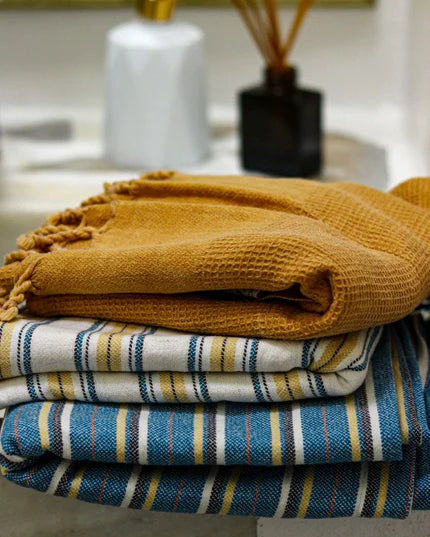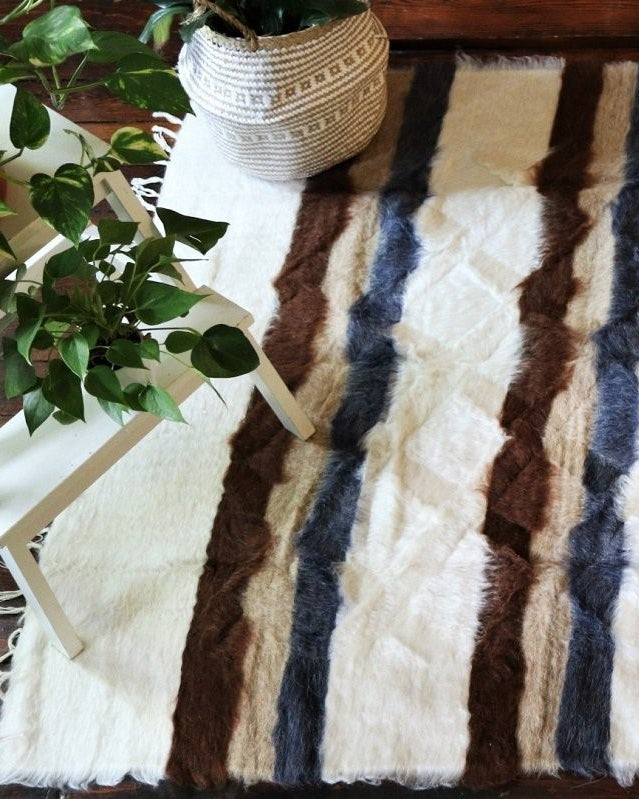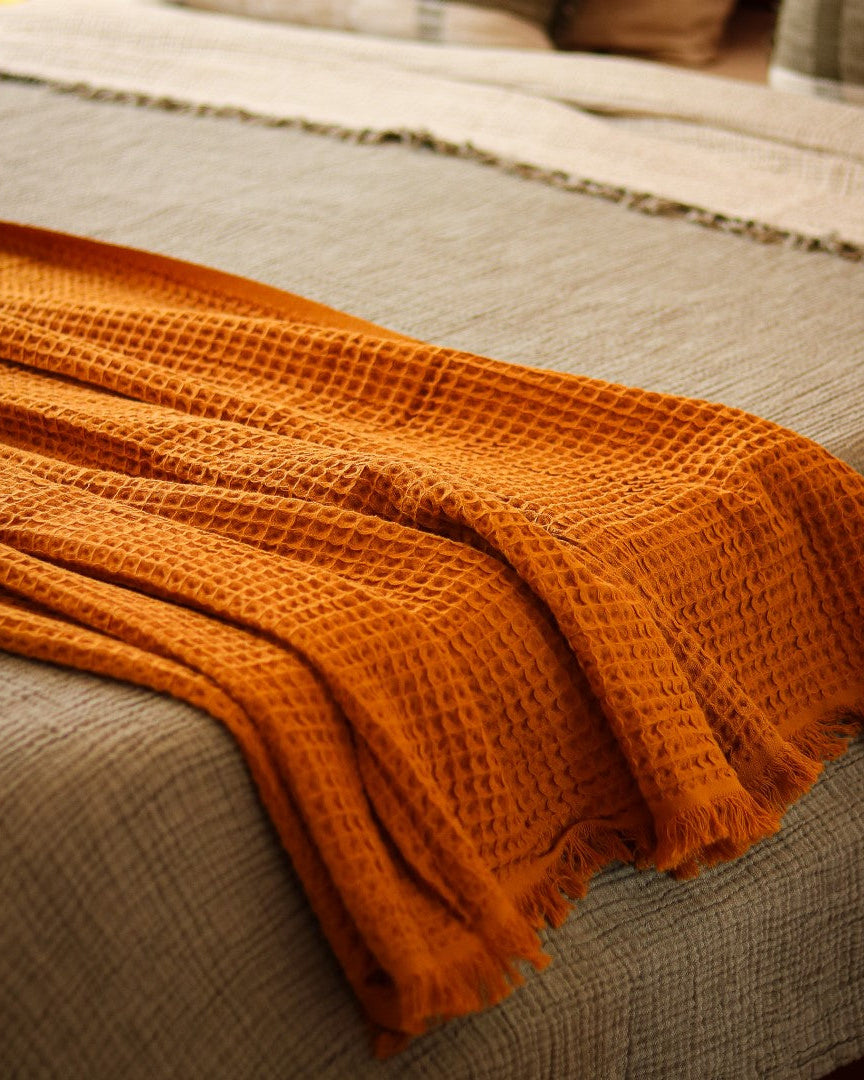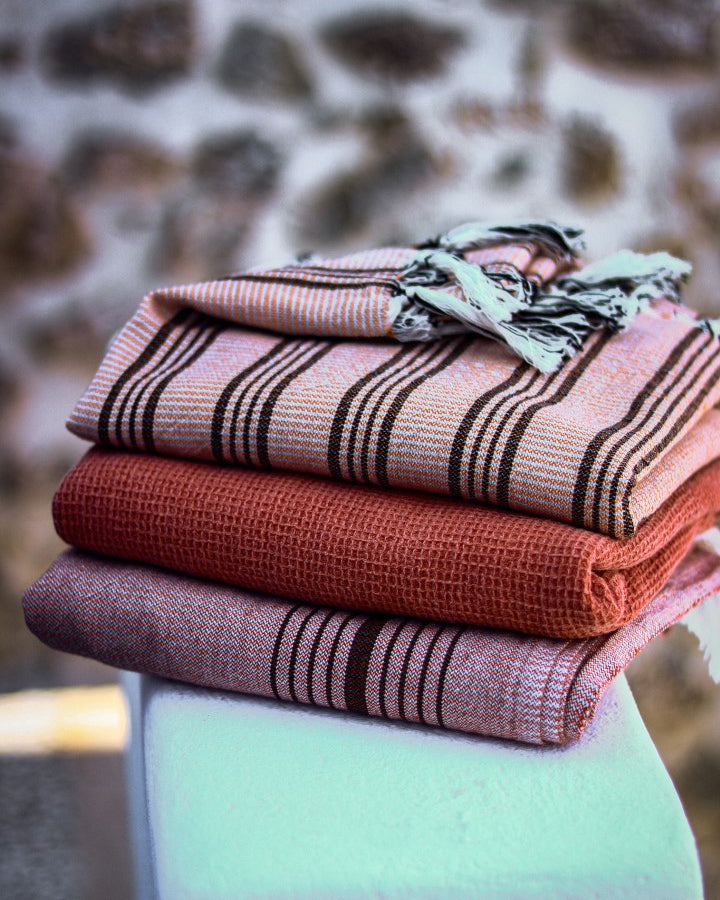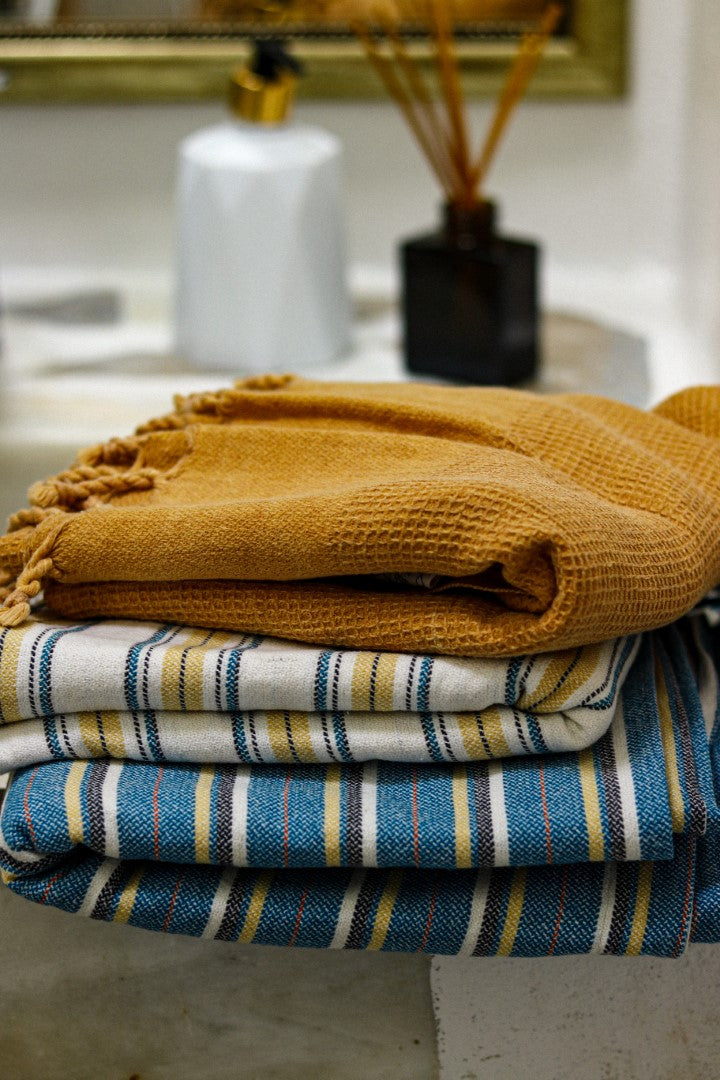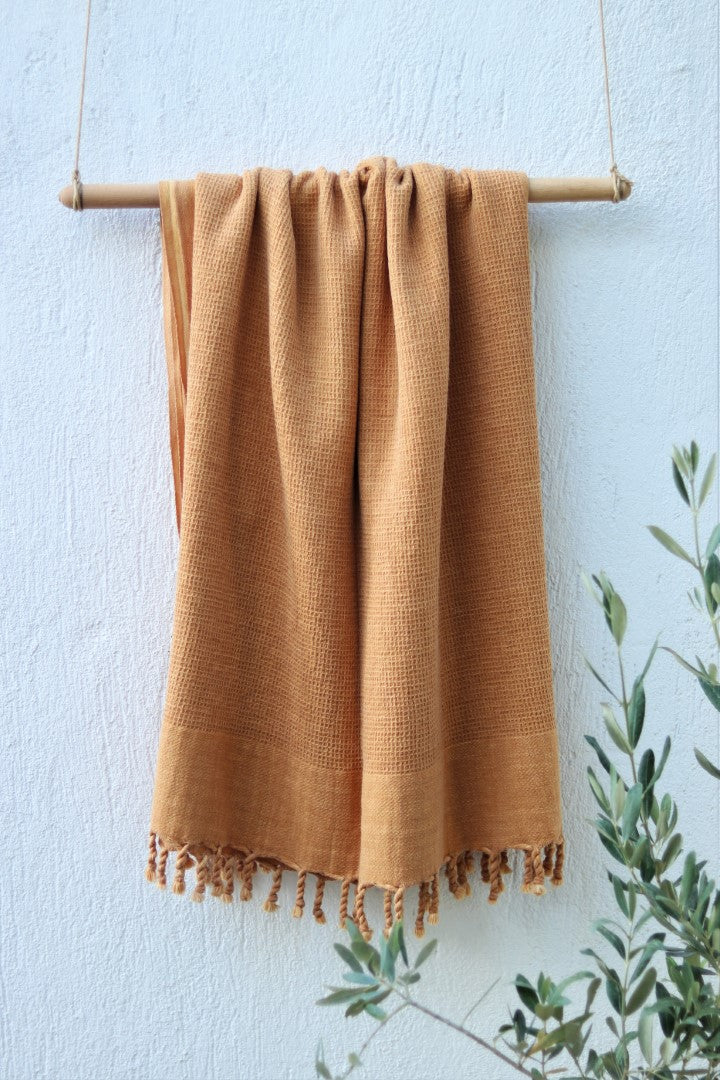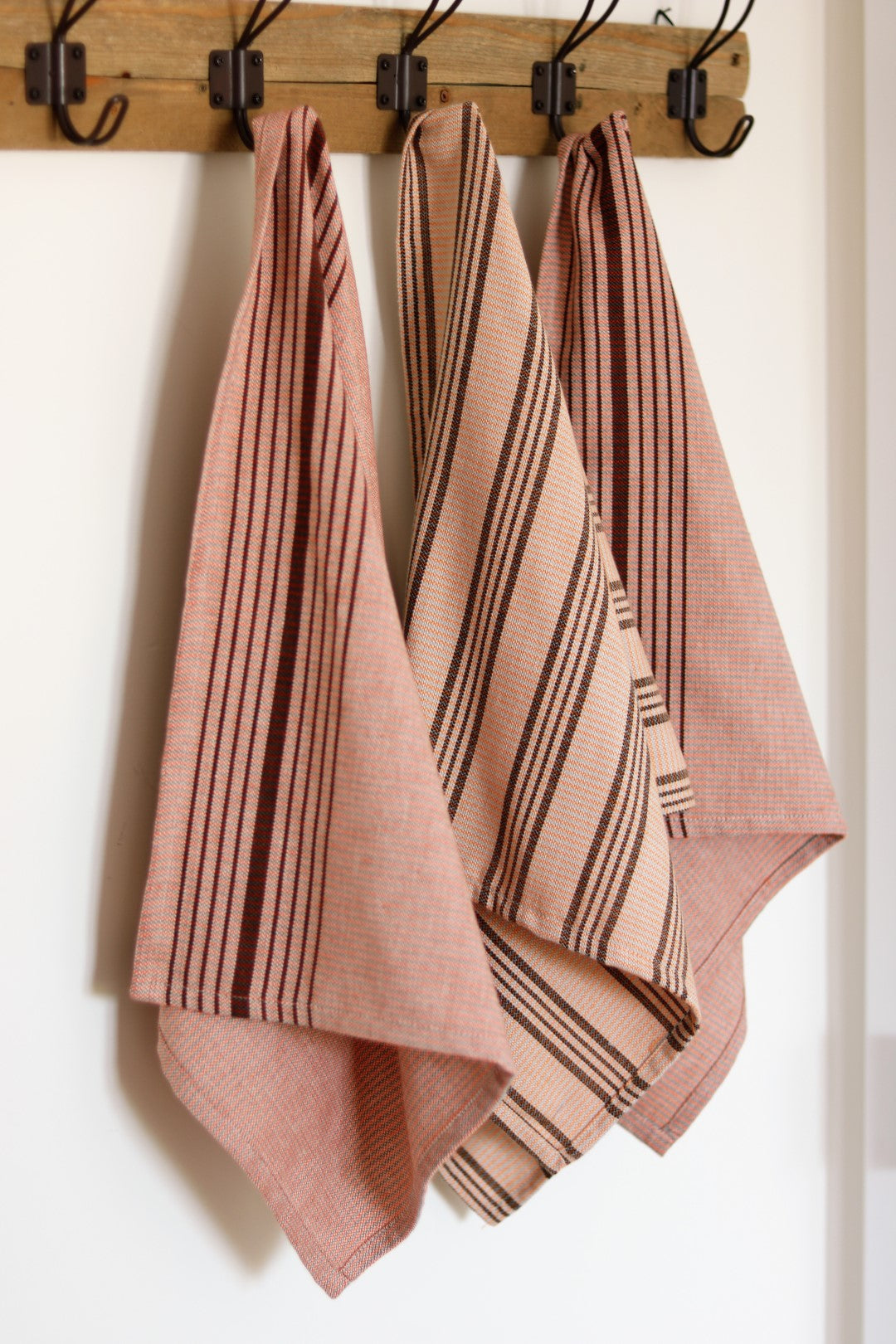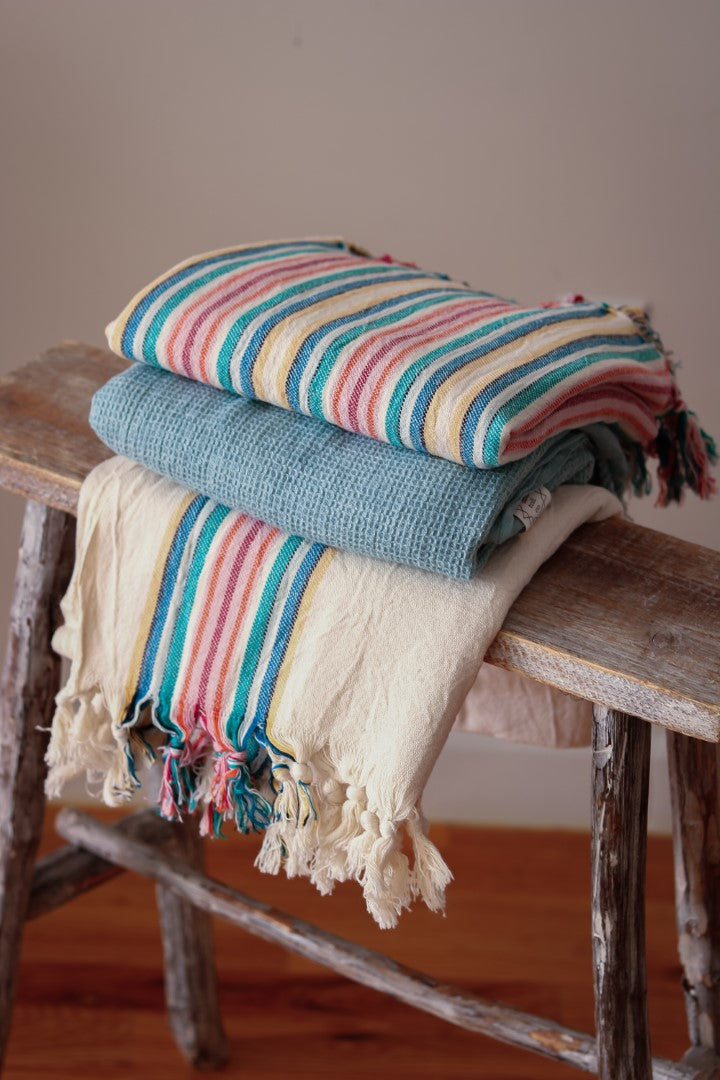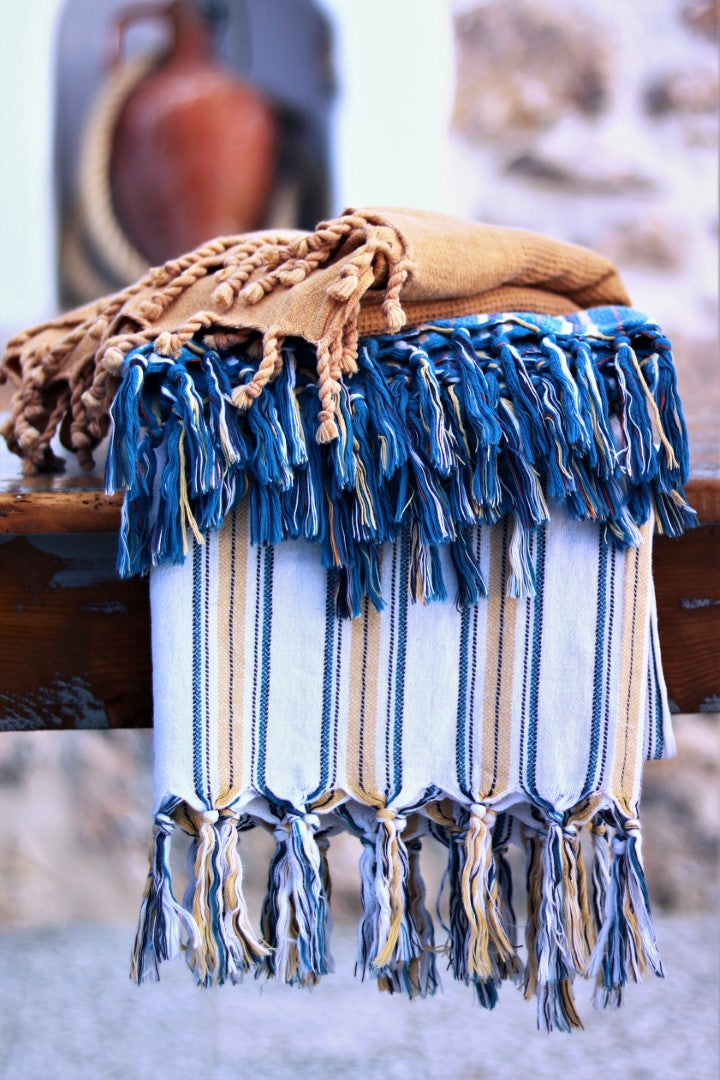It’s a good rule of thumb to replace your bath towels every 1 to 2 years. This simple habit ensures the towels you use every day are still doing their job—staying absorbent, soft, and hygienic.
Of course, not all towels are created equal. Hand towels and washcloths usually get a lot more action and hit the laundry basket more often, so they'll likely need replacing sooner. Sticking to a regular replacement schedule is one of the easiest ways to keep your home healthy and your linens feeling fresh.
Understanding the Towel Replacement Timeline
It helps to think of your towels like any well-loved tool. Over time, all that drying and washing takes a toll. The fluffy fibers that once soaked up water so well begin to break down, leaving your towel less absorbent and a little rough around the edges.
Even the highest quality towels, like those made from premium Turkish cotton, have a finite lifespan. While proper care can certainly extend their life, eventually, every towel reaches a point where it's time to retire it.
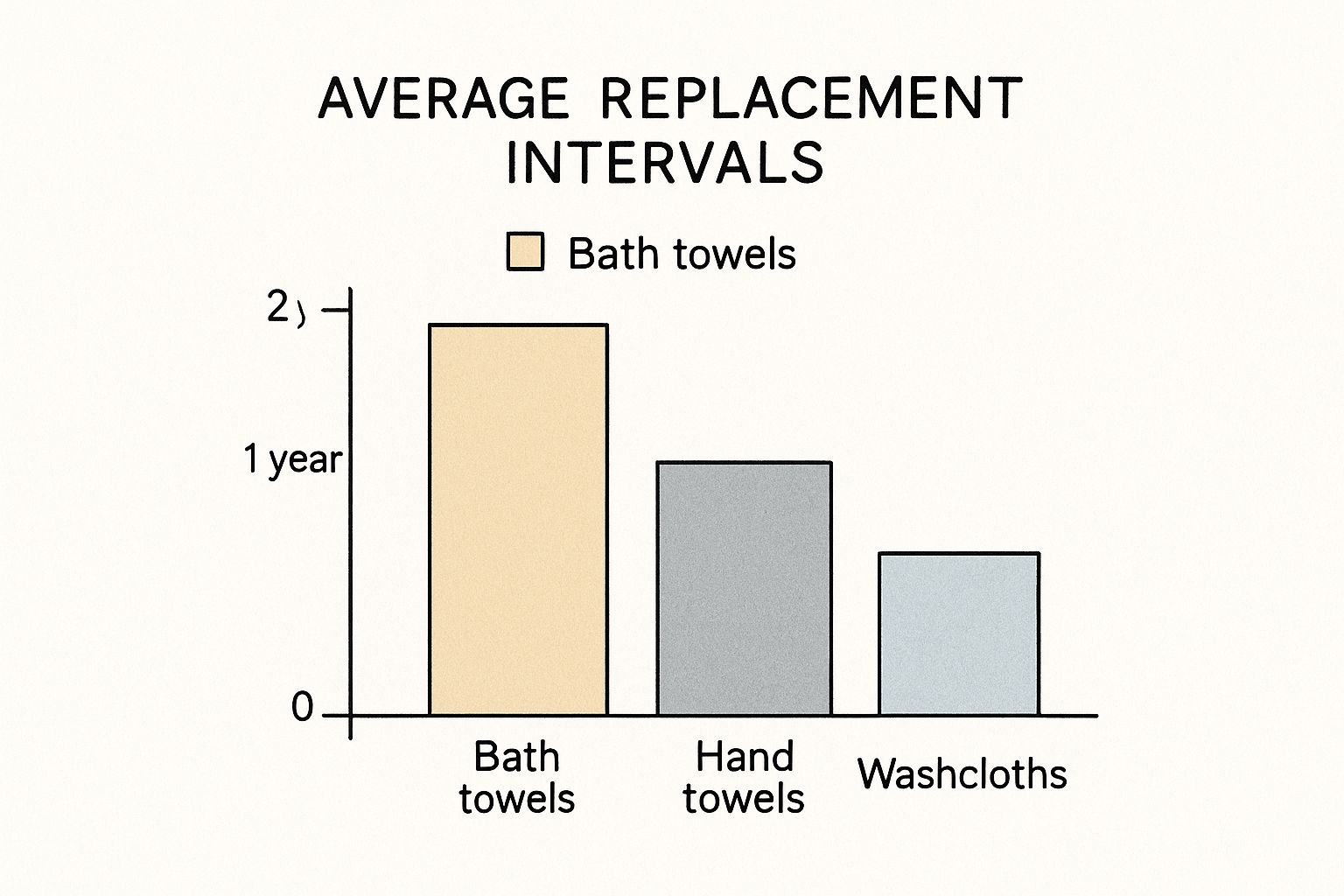
As you can see, the items that see the most frequent use and washing, like washcloths, have the shortest lifespan. One of the biggest red flags is a lingering musty smell that just won't wash out. If you've tried everything and that odor persists, it's a clear sign the towel's fibers have trapped too much buildup.
If you're dealing with stubborn odors, you might find some useful tips in our guide on how to remove smells from towels.
Towel Replacement Quick Guide
To make things simple, here’s a quick-reference table that breaks down the recommended replacement timelines for the most common towels in your home.
| Towel Type | Recommended Replacement Frequency |
|---|---|
| Bath Towels | Every 1 to 2 years |
| Hand Towels | Every 1 year |
| Washcloths | Every 6 to 12 months |
Keep in mind that these are general guidelines. If you see signs of wear and tear or notice a drop in performance sooner, it's always best to trust your judgment and swap them out.
What Really Lives on Your Towels
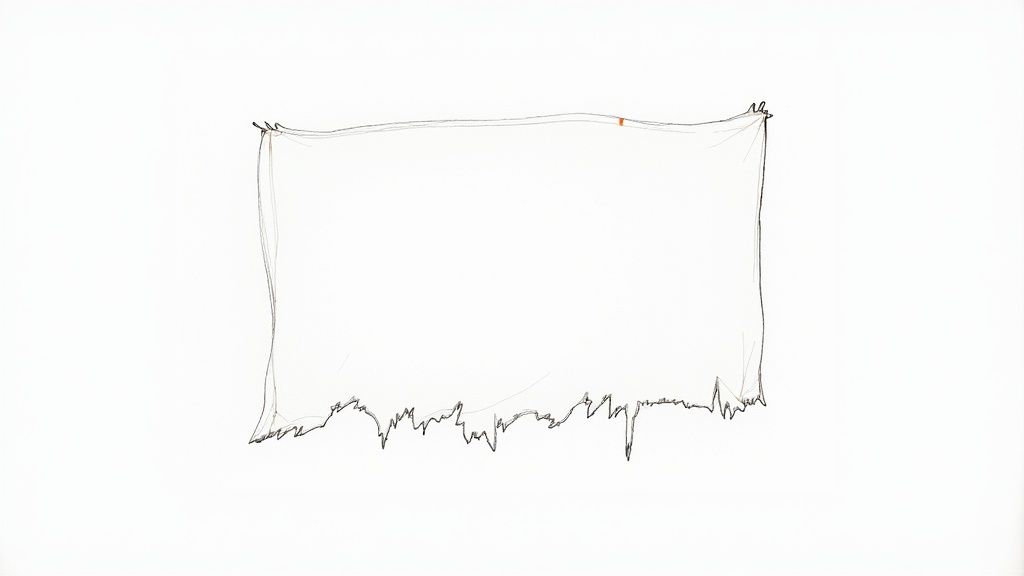
It’s a common mistake to think your towel is clean just because you only use it when you're clean. But the moment you start drying off, you're transferring dead skin cells, body oils, and a whole world of microscopic organisms from your skin to the fabric.
That organic matter, combined with the lingering dampness in a steamy bathroom, creates a perfect storm. Your towel essentially becomes a five-star resort for bacteria, mold, and mildew. In these warm, moist conditions, some microbes can double their population in just 20 minutes.
From Unseen Threats to Real Health Concerns
This isn't just about the "ick" factor; that microscopic party happening on your towel can have real-world consequences for your health. A towel loaded with bacteria can cause a host of problems, especially if you have sensitive skin or a weaker immune system.
Here’s what you might be up against with a dirty towel:
- Skin Irritation and Acne: Wiping bacteria back onto your clean skin is a fast track to clogged pores, which can easily lead to breakouts and inflammation.
- Fungal Infections: Towels can become carriers for the fungi that cause things like athlete's foot and ringworm, potentially spreading them from one part of your body to another.
- Allergic Reactions: The spores from mold and mildew are notorious for triggering allergies and can make asthma symptoms much worse for those who are sensitive.
Think about it: a towel touches every part of your body. If it's not truly clean, you could be spreading germs from one area to a more vulnerable one, like your face.
This is exactly why knowing how often to wash your towels is just as important as knowing when to replace them. Most hygiene experts agree you should wash bath towels after just three to five uses to keep that bacterial growth under control. It's surprising, but a recent study found that about one-third of people only washed their towels once a month—a major gap in basic home hygiene. For a deeper dive, you can learn more about proper towel hygiene from consumer health reports.
Ultimately, the question of "how often should you replace towels" is tied directly to their cleanliness. An old, worn-out towel is much harder to get fully clean and takes longer to dry, making it an even more inviting place for all those unwanted microbial guests.
Five Signs Your Towels Are Past Their Prime
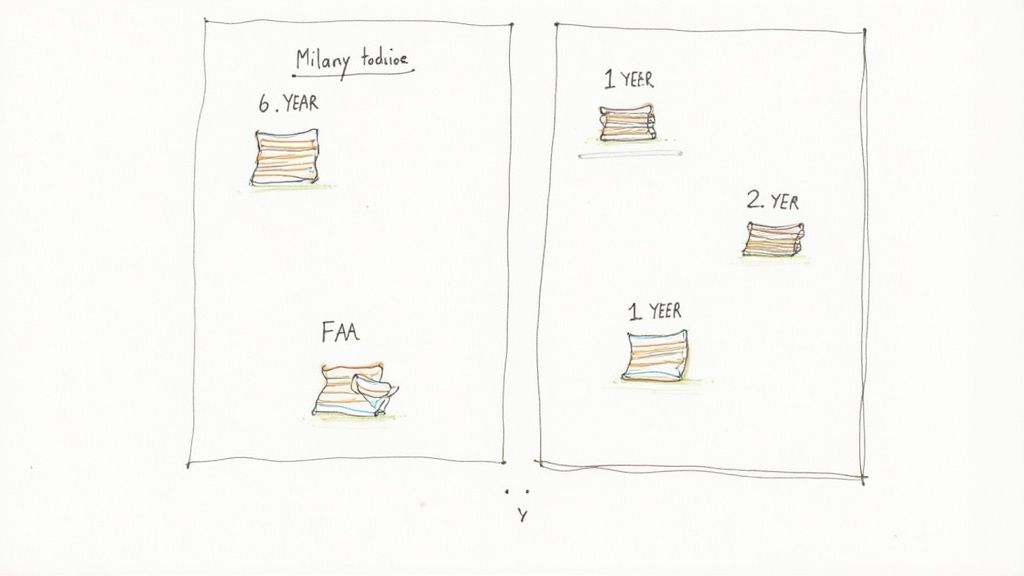
Forget the calendar for a second. Your towels have their own way of telling you when they’re ready for retirement. While general timelines are a good starting point, the best way to know for sure is to just pay attention.
When a towel is truly done, it stops doing its one essential job well. Trust what you see, feel, and smell—your senses will give you all the clues you need.
1. It Loses Its Thirst for Water
The most obvious sign of a towel on its last legs is that it just doesn't absorb water anymore. A good, healthy towel practically drinks the moisture off your skin. An old one? It feels more like you're just pushing water around, leaving you damp and a little frustrated.
This happens because years of washing, drying, and even fabric softeners eventually break down the cotton fibers. If drying off feels more like a chore than a comfort, your towel has lost its thirst.
2. A Funky Smell That Won’t Quit
You know the smell. You pull a towel from the dryer, and it smells great. But after just one use, that familiar musty, mildewy odor is back with a vengeance. That’s a major red flag.
A persistent smell that survives a hot wash cycle means bacteria and mold have set up a permanent home deep in the towel's fibers. At this stage, no amount of washing will ever truly get it clean. It's time to say goodbye.
3. You Can See Through It
Here's a simple test: hold your towel up to the light. Do you see thin patches or spots where the fabric is noticeably worn? Can you spot tiny holes or fraying edges? These are the towel equivalent of wrinkles—clear signs of a long, hard life.
Those weak spots aren't just cosmetic; they're future rips waiting to happen, rendering the towel useless.
4. It Feels Like Sandpaper
Remember how incredibly soft and plush that towel felt when you first brought it home? Now, does it feel rough, scratchy, or stiff against your skin? That's a classic sign of damaged and coarse fibers.
Not only is it unpleasant to use, but a scratchy towel can also be genuinely abrasive, which is especially bad news for anyone with sensitive skin.
5. Stubborn Stains Have Moved In
Some stains are just stubborn. Things like makeup, body lotions, or hair dye can be almost impossible to remove completely. While one little spot isn't a dealbreaker, a towel covered in permanent splotches just looks dingy and unhygienic.
If you’ve tried every stain treatment you can think of and those marks still won't budge, it's probably best to retire it from bathroom duty.
How to Make Your Towels Last Longer
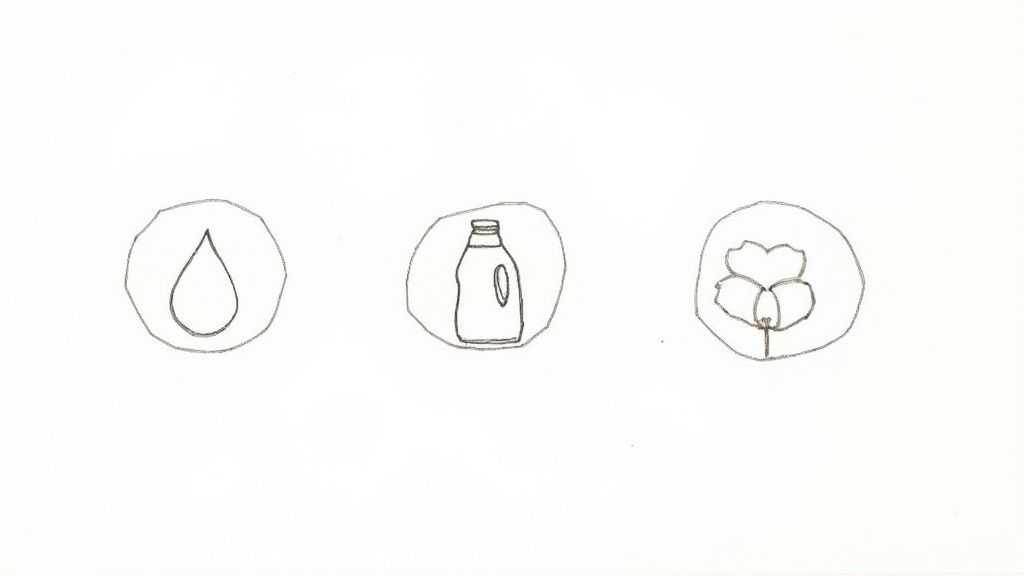
It’s frustrating to feel like you're constantly replacing worn-out towels. The good news is that you can get a lot more life out of them with just a few mindful habits in the laundry room. A couple of small tweaks can keep your towels soft, absorbent, and vibrant for years.
Think twice before reaching for the fabric softener. It might seem counterintuitive, but that silky liquid actually coats cotton fibers with a waxy film. Over time, this buildup makes your towels less absorbent—essentially waterproofing them.
Instead, pour about a half-cup of white vinegar into the rinse cycle. It’s a fantastic natural alternative that cuts through soap residue, softens the fibers, and even helps eliminate any musty smells, all without harming your towel's thirst.
Smart Washing and Drying Techniques
The secret to long-lasting towels starts in the wash. Jamming too many into the machine means they won’t get properly cleaned or rinsed, leaving detergent and grime trapped deep in the fibers. For best results, give your towels their own dedicated load.
- Choose the Right Temperature: Stick to warm water, not hot. While hot water is great for sanitizing, it’s harsh on towels, causing colors to fade and breaking down the cotton fibers much faster.
- Go Easy on Detergent: More soap isn't better. Using too much detergent creates a mountain of suds that's hard to rinse away completely, leaving behind a stiff residue that attracts even more dirt.
- Shake Them Out: Before tossing your towels in the dryer, give each one a vigorous shake. This simple step fluffs up the loops, helping them dry faster and feel much softer.
Of course, none of these tips matter much if your washer isn't working correctly. If you suspect an issue, it's always a good idea to look into professional washing machine repair services to keep things running smoothly.
The single best thing you can do for your towels between washes is to let them breathe. Never leave a damp towel bunched up on the floor or in a hamper; always hang it to dry completely.
This simple act is your best defense against mildew and keeps the fibers from getting that funky, closed-in smell. For more specialized care instructions, you can learn how to care for your Turkish towel in our detailed guide.
Choosing Your Next Set of Towels
When your old towels have finally given up, it's tempting to just grab the first replacement set you see. But thinking about your next purchase as a long-term investment in your comfort can make a huge difference. A little bit of knowledge upfront will help you choose towels that not only feel amazing but also last for years.
The labels on new towels can feel a bit like a foreign language, but they tell you everything you need to know. You'll almost always see Egyptian and Turkish cotton mentioned. Both are fantastic, top-tier options known for their long, durable fibers that create an incredibly soft feel. The key difference is how they handle water: Egyptian cotton is like a sponge and soaks up moisture like nothing else, while Turkish cotton is a bit less absorbent but dries much faster. This makes it a brilliant choice if you live somewhere humid. You can dive deeper into this in our guide on what is Turkish cotton.
Decoding Towel Density and Modern Fabrics
Another term you absolutely need to know is GSM, which stands for grams per square meter. Think of it as a towel's density rating.
- A lower GSM (300-400) gives you a lighter, thinner towel that’s quick to dry—perfect for a gym bag or travel.
- A higher GSM (600-900) means a thick, plush, and super-absorbent towel that feels like a warm hug but will take its sweet time drying.
For most of us, the sweet spot for a daily bath towel is somewhere between 500 and 700 GSM. It gives you that great absorbency without staying damp for ages.
The bath towel market, which is worth over $11.3 billion in 2024, is changing fast, largely because we're all more focused on health and wellness. This has sparked some cool innovations in towel technology. For example, you’ll now find towels with antimicrobial properties, often using silver-ion treatments that stop bacteria from growing and keep musty smells away. This is a game-changer for keeping towels fresher longer and directly tackles the hygiene issues we talked about earlier.
Investing in a towel with a higher GSM or antimicrobial features might cost more initially, but it often pays off. These towels are more durable and stay hygienic longer, extending the time until you need to replace them.
A Few More Questions About Towel Care
Even after you've got a handle on when to replace your towels, a few practical questions always seem to come up. Let's tackle some of the most common ones to round out your towel care expertise.
What About Kitchen Towels? Do They Follow the Same Rules?
Not at all. Kitchen towels live a much rougher life than their bathroom counterparts, and they need to be replaced far more often. Think about it—they’re on the front lines, wiping up spills, drying hands after handling raw ingredients, and cleaning countertops. This makes them a hotspot for cross-contamination with nasty bacteria like E. coli.
All that heavy use and constant washing takes a serious toll, breaking down their fibers much more quickly. A good rule of thumb is to replace kitchen towels every 6 to 12 months. If they start holding onto stubborn stains or a sour smell that just won’t quit, it's time for them to go, even if it's sooner.
What Can I Do with My Old Towels?
Tossing old towels in the trash feels like such a waste, because it is! Before you send them to a landfill, think about giving them a second act. A towel that’s too scratchy for your skin is often perfect for messier, tougher jobs.
Here are a few ways to give them a new purpose:
- Create Cleaning Rags: Cut them up into smaller pieces for household chores, washing the car, or tackling that messy garage project.
- Donate to a Shelter: Animal shelters and vet clinics are almost always in need of towel donations to create cozy bedding for animals.
- Use as Packing Material: They're perfect for wrapping fragile items when you're moving or putting things into storage.
Thinking about the bigger picture of home hygiene? It can be helpful to see the general cleaning frequency for household items to put your towel habits in context.
Investing in a higher-quality towel isn't just about feeling pampered; it's a practical decision for longevity. Premium materials like long-staple Turkish cotton are built to last, holding up better to repeated washing while staying soft and absorbent for years.
Yes, the initial price tag is higher, but a well-crafted towel can easily outlast a cheap one, saving you money over time. You get better performance from the very first use and push back the date when you have to start asking, "How often should I replace my towels?" all over again.
Ready to invest in towels that combine timeless craftsmanship with lasting quality? The artisans at Anatolico create small-batch Turkish towels that are exceptionally soft, absorbent, and designed to last. Experience the difference at https://www.anatolico.co.

